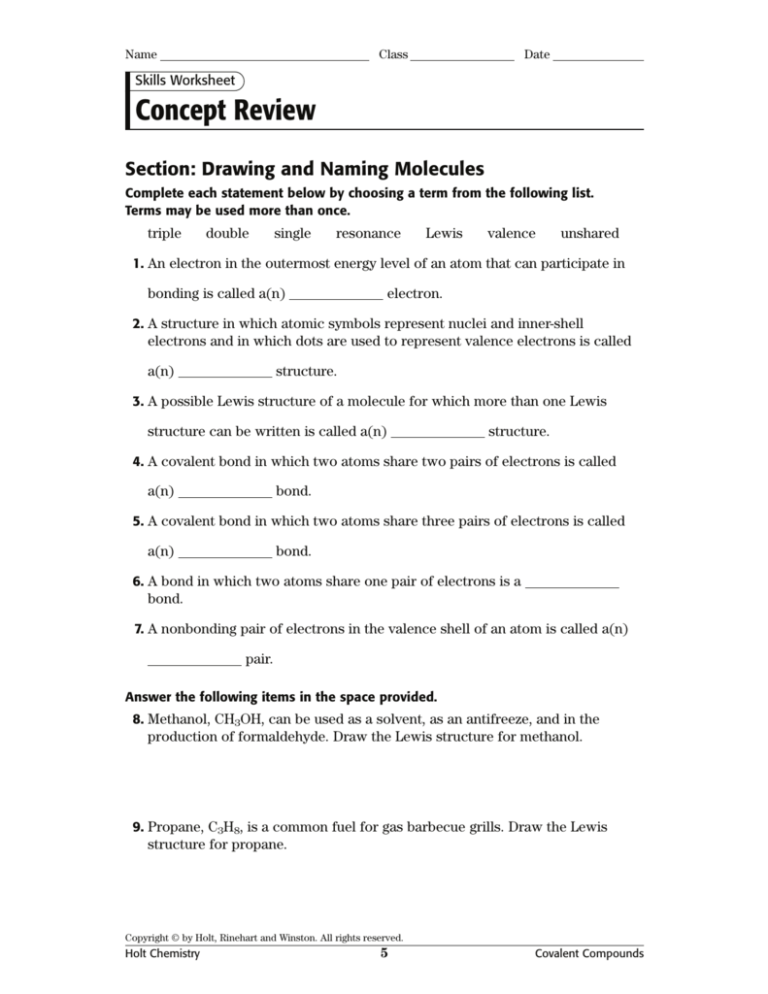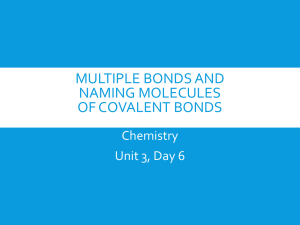
Name
Class
Date
Skills Worksheet
Concept Review
Section: Drawing and Naming Molecules
Complete each statement below by choosing a term from the following list.
Terms may be used more than once.
triple
double
single
resonance
Lewis
valence
unshared
1. An electron in the outermost energy level of an atom that can participate in
bonding is called a(n)
electron.
2. A structure in which atomic symbols represent nuclei and inner-shell
electrons and in which dots are used to represent valence electrons is called
a(n)
structure.
3. A possible Lewis structure of a molecule for which more than one Lewis
structure can be written is called a(n)
structure.
4. A covalent bond in which two atoms share two pairs of electrons is called
a(n)
bond.
5. A covalent bond in which two atoms share three pairs of electrons is called
a(n)
bond.
6. A bond in which two atoms share one pair of electrons is a
bond.
7. A nonbonding pair of electrons in the valence shell of an atom is called a(n)
pair.
Answer the following items in the space provided.
8. Methanol, CH3OH, can be used as a solvent, as an antifreeze, and in the
production of formaldehyde. Draw the Lewis structure for methanol.
9. Propane, C3H8, is a common fuel for gas barbecue grills. Draw the Lewis
structure for propane.
Copyright © by Holt, Rinehart and Winston. All rights reserved.
Holt Chemistry
5
Covalent Compounds
Name
Class
Date
Concept Review continued
10. Draw the Lewis structure for water, H2O.
11. Draw the Lewis structure for carbon monoxide, CO.
12. Draw the Lewis structure for the rocket propellant nitryl fluoride, NO2F.
13. Draw the Lewis structures for SO 232.
Answer the following item in the space provided.
14. Explain the difference between single, double, and triple bonds.
Copyright © by Holt, Rinehart and Winston. All rights reserved.
Holt Chemistry
6
Covalent Compounds
Name
Class
Date
Concept Review continued
Use the system of prefixes and the rule for suffixes to name the following
compounds.
15. PbCl2
16. KCl
17. LiO2
18. As2O3
19. PBr3
20. SF4
21. N2O5
Write the formulas for the following compounds.
22. nitrogen monoxide
23. carbon dioxide
24. carbon tetrachloride
25. carbon disulfide
Copyright © by Holt, Rinehart and Winston. All rights reserved.
Holt Chemistry
7
Covalent Compounds
TEACHER RESOURCE PAGE
Answer Key
9. Typical properties of substances with
metallic bonds: average melting and
boiling points, soft, silvery, and solid,
conducts electricity as a solid. Typical
properties of substances with ionic
bonds: high melting and boiling points,
crystalline, white solid, conducts electricity when dissolved in water.
Typical properties of substances with
covalent bonds: low melting and boiling points, usually a liquid or a gas,
not a good conductor of electricity.
10. length
11. energy
12. electronegativity
13. nonpolar covalent
14. polar covalent
15. dipole
16. nonpolar covalent
17. polar covalent
18. ionic
19. ionic
20. nonpolar covalent
21. nonpolar covalent
22. polar covalent
23. polar covalent
Concept Review: Covalent
Bonds
1. A covalent bond forms when two or
more valence electrons are attracted
by the positively charged nuclei of two
atoms and thus are shared between
both atoms.
2. The H2 molecule is stable because
each hydrogen atom now has a shared
pair of electrons and has achieved a
stable noble gas configuration.
3. Molecules are stable when they
achieve a noble gas configuration with
an outer shell of 8 electrons. Hydrogen
is the exception to this rule since it
achieves a noble gas configuration
when it has two electrons in its outer
shell.
4. In a covalent bond, atoms share one
or more pairs of electrons. In an ionic
bond, one atom transfers electrons to
another.
5. A molecular orbital is a region in
which there is high probability that an
individual electron exists as it travels
with a wavelike motion in the threedimensional space around one of two
or more associated nuclei.
6. When two hydrogen atoms approach
each other, the potential energy of the
combination becomes lower and lower
until it reaches a minimum value of
2436 kJ/mol at a distance of 75 pm.
7. As a covalent bond forms between
two hydrogen atoms, the atoms reach
a distance from each other at which
attractive and repulsive forces are balanced and the total energy of the system is at a minimum. At this minimum
energy state, the molecule is most stable.
8. Atomic nuclei are not rigid and fixed,
but they vibrate back and forth. This
vibration means that the distance
between nuclei is constantly changing,
so bond length the average distance
between the nuclei.
Concept Review: Drawing
and Naming Molecules
1.
2.
3.
4.
5.
6.
7.
8.
valence
Lewis
resonance
double
triple
single
unshared
H
HICIOIH
9.
H
H H H
HICICICIH
H H H
Copyright © by Holt, Rinehart and Winston. All rights reserved.
Holt Chemistry
41
Covalent Compounds
TEACHER RESOURCE PAGE
10. HIOIH
Concept Review: Molecular
Shapes
11. CK O
12. OJ NIF ←→ OINIF
O
13.
1. VSEPR theory predicts the general
shape of a molecule based on its
Lewis structure.
2. a.
H
O
2−
O
S
O
HICIH
O
H
b.
14. A single bond is one in which two
atoms share one pair of electrons. A
double bond is one in which two
atoms share two pairs of electrons. A
triple bond is one in which two atoms
share three pairs of electrons.
15. lead dichloride
16. potassium chloride
17. lithium dioxide
18. diarsenic trioxide
19. phosphorus tribromide
20. sulfur tetrafluoride
21. dinitrogen pentoxide
22. NO
23. CO2
24. CCl4
25. CS2
Cl
ClICICl
Cl
c. OINJ O ←→ OJNIO
3.
4.
5.
6.
a. shape: tetrahedron
b. shape: tetrahedron
c. shape: bent
The electrons in the unbonded pair
repel bonding electrons as far away as
possible from it.
Multiple unbonded pairs of electrons,
as in the oxygen atom of H2O, can
repel each other as well as bonding
electrons, and form a bent molecule.
The energy required to separate polar
molecules is greater than that required
to separate nonpolar molecules.
Shape and polarity can affect how a
molecule fits into another structure
and how it tastes. It can affect how
easy the molecule is to separate and
its attraction to positively or negatively charged objects.
Copyright © by Holt, Rinehart and Winston. All rights reserved.
Holt Chemistry
42
Covalent Compounds








